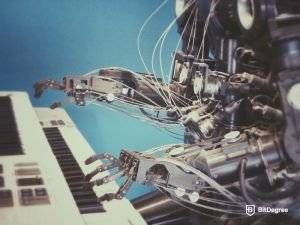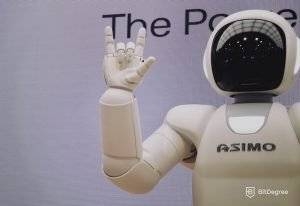Free Airdrop Season 7 is LIVE! Answer fun questions or do simple tasks to earn rewards from the $30K BitDegree prize pool. Participate Now ! 🔥
With the ongoing constant change of the digital environment, you can recognize that many labor processes are getting repetitive and need to be replaced. The fact that many companies and their clients expect better and better results, fewer resources, ensured consistency and quality is no surprise at all. Robotic process automation is a big step in business industries that take away the manual work and replace it with automated movements. This way, the robotic process automation process allows the workers to spend their on other tasks, like improving the quality of the product, delivery, etc. But what is RPA so special about?
Specialized computer programs, or better known as software robots, can perform repetitive, repeatable business processes for an extended period of time compared to humans. The brightest future is predicted to those business models, that will be able to combine the workforces of both, robotic automation and human beings. By completely removing the human error in quality assurance, the RPA increases the satisfaction of the customers by a great percent. Not to mention the reduced time in delivery systems, reduced costs of the product making, and increased number in return of investment.
Working as virtual assistants, robotic bots can create numerous benefits for the employees and generate revenue through different tasks. What are the basics to know about RPA?
Table of Contents
Robotic Process Automation Basics

Follow the Datacamp promo code link & get an exclusive 25% OFF Datacamp subscriptions. Act now while the offer is still available!
One of the main ideas behind the whole what is RPA idea is that bots can perfectly mimic the work of a person across many different applications and user interfaces, work between multiple system routines and fill out the gaps where the worker seems to struggle. The bots of RPA can perform such tasks as logging in and out of the applications, managing data resources, operating emails and their attachments.
While this may seem like a macro software technology that works in a linear command-type of way, the robotic process automation bots have grown and are capable of flexibly and intuitively responding to the changes in the business. By making such actions, it increases bot intelligence over time.
The dynamic way of the robotic process automation makes it quite different solutions than the bots that were used previously. At this given point, the RPA is divided into three different sections - chatbots, knowbots, and probots.
- Chatbots – the virtual support system that responds to the users/customers queries when asked.
- Knowbots – the bots that search for information on the internet and store the user-specified needs.
- Probots – process the data by following simple, repeatable rules.
What is RPA so interesting about is that it belongs in the top of the whole organization’s IT infrastructure. While the RPA technology might look like a complex system to enable, alternatively, it is implemented into the IT infrastructure without changing the existing systems. One of the key elements of RPA that distinguishes it from the other similar technologies is that it is able to adapt to needed circumstances, exceptions, and new situations. Once it is set to capture and interpret the actions of specific processes in existing software, it can single-handedly start to manage data, trigger responses, communicate with other systems and create new actions and tasks.
What are the Benefits of RPA?
Besides being a cost-effective tool, the RPA provides countless benefits for its users:
- Easy to establish. To configure a software robot, you don’t need a lot of knowledge of IT. Since it is a code-free technology, almost any of the employees with basic IT fundamentals can use the drag and drop process designer to set up the software. They can even record their own steps so they bot could learn from it.
- Disabling human error. There is no denying that human is not perfect and can make simple, quite silly errors during different tasks. This is exactly one of the key features what is RPA bringing to the table. Robotic process automation is consistent and accurate - it can’t do the same mistakes that human employees do. No typos, no miss-clicks. It can be implemented in many systems where human knowledge is not needed.
- Meeting the regulatory compliance standards. Since bots are only taught to do what is only needed or goes by the instructions, they can perform strict tasks 24/7 and rewind the actions that have been done for a review.
- No interruptions. While human employees need breaks, food, rest, etc., for doing certain actions, computer software can perform operations tirelessly and autonomously.
- No changes in the current system. Many of the automation bots need to be installed into the system and require certain changes in it. The RPA makes no disruption to the system, it works across the presentation layer of existing applications the same way as the person works.
- Improved work of the employee. One of the main reasons that technology advances even further, is that it needs to make people’s life better and better. As mentioned slightly above, what is RPA doing is that it makes the work experience for the employee more enjoyable, since he or she can spend their time doing something more important or interesting. This also leads to increased productivity.
The robotic process automation has been significantly improving over the years and the next generations will find it hard to understand how people worked before without it. Combined with uprising technologies such as machine learning or artificial intelligence, RPA will be able to work even more accurately, faster, and handle problems better.
Choosing the Right RPA Software

Although the whole robotic process automation sounds like a great helping hand for any organization that deals with a lot of manual work, there are some features that should not be overlooked when picking the software program.
Here are the key features:
- Reliability. Handing over a huge amount of tasks to a robot software can seem untrustworthy at first. This is why reliability is so important. You should look for the RPA software that has built-in monitoring systems analytics to be able to review the program at any given time.
- Speed. Speed is for what is RPA known for. Bots that work slowly might not only interrupt the work of an organization but also bring great disadvantages. If you are considering to replace manual human labor, try looking for a robotic software that is optimized to work quickly and more efficiently than a person.
- Intelligence. The best computer intelligence software programs can do the work of multiple human workers, work on task-based activities, read, write and collect data, and take advantage of it in further processes.
- Simplicity. Although the software that intelligent, fast, and reliable can seem like a hard one to master, there is no need to look for difficult ones. Look for a product that is simple and understandable to every co-worker. This way you can bring more benefits to an organization that having difficult software that is understood only by a few.
Where is RPA Used?

To have a better understanding of what is RPA and what are the ways of using it, it is useful to review the industries in which it can be used.
- Healthcare. Medical organizations can use RPA for handling patient medical history, records, claims, billing, analysis, and reports.
- Financial services. There are numerous benefits that can be provided by the RPA in financial service area. Managing foreign accounts, payments, audits can take a while for employees, but a robotic software can do it instantly.
- Customer service. Automated robotic software that is capable of verifying documents, information, contacts, e-signatures, can significantly improve the quality of customer service and increase the satisfaction of the users.
- Supply chain management. The RPA is used for procurement, automating order processing and payments, monitoring inventory levels and tracking shipments.

Did you know?
Have you ever wondered which online learning platforms are the best for your career?
Overview
The robotic process automation is often used as a mechanism to increase the return on investment or to reduce costs. You need to be open-minded towards the results of RPA, although quick wins are possible with it, you have to set expectations for the long-run. While IT professionals are not needed in the process of implementation and understanding of what is RPA, it is highly suggested that they should be involved to secure maximum results. If you are keen to learn more about the world of computer science, head over to BitDegree courses and tutorials sections and increase your knowledge base today!













